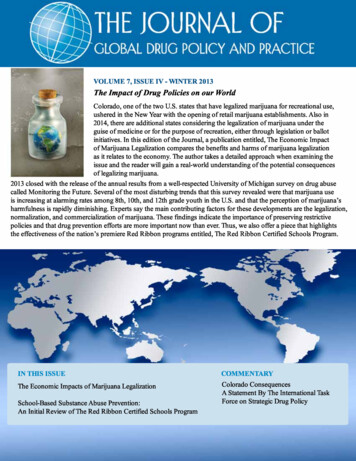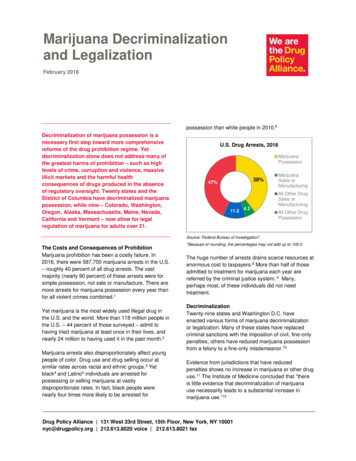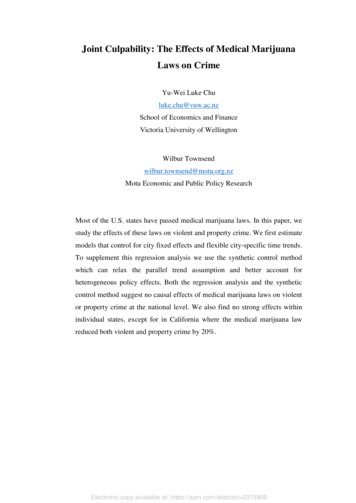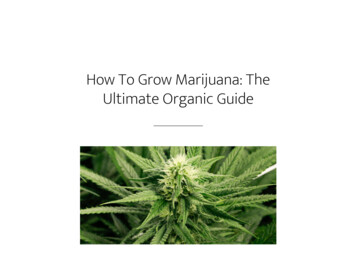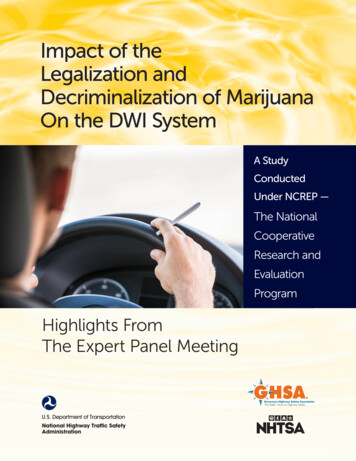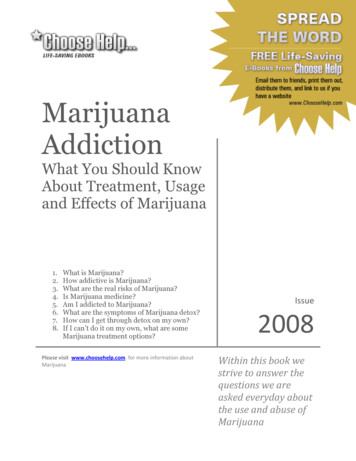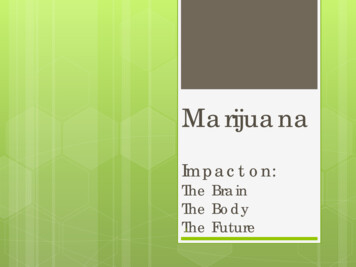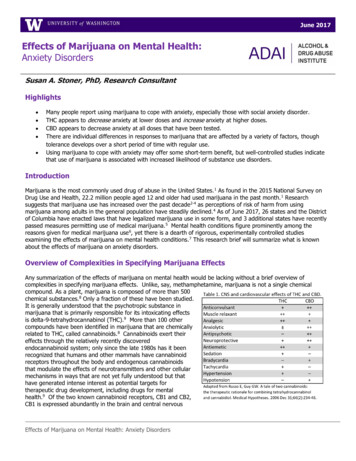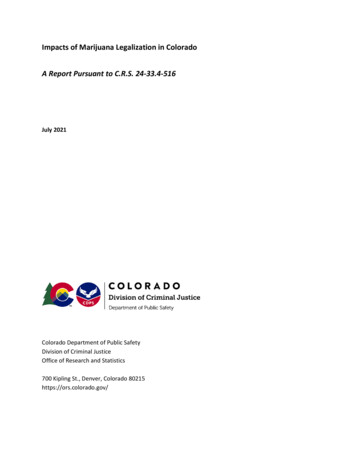
Transcription
Impacts of Marijuana Legalization in ColoradoA Report Pursuant to C.R.S. 24-33.4-516July 2021Colorado Department of Public SafetyDivision of Criminal JusticeOffice of Research and Statistics700 Kipling St., Denver, Colorado 80215https://ors.colorado.gov/
Impacts of Marijuana Legalization in ColoradoA Report Pursuant to C.R.S. 24-33.4-516July 2021Prepared byJack K. Reed, Statistical AnalystOffice of Research and StatisticsStan Hilkey, Executive Director, Department of Public SafetyJoe Thome, Director, Division of Criminal JusticeKim English, Research Director, Office of Research and Statistics
i
iiTable of ContentsExecutive Summary. 1Section One Introduction . 8Background, Limitations and Methods . 8Data limitations . 9Data Sources . 10Data Collection Methodology . 11Brief History of Marijuana Laws . 11State Marijuana Legal Landscape . 16Organization of this Report . 18Summary . 18Section Two Impact on Public Safety . 19Overview . 19Offenses and Arrests . 20Marijuana Court Case Filings . 27Crime around Marijuana Establishments . 31Traffic Safety . 33Probationer Drug Test Results . 50Diversion Out of State . 55Transfer Using Parcel Services . 56Section Three Impact on Public Health and Behavioral Health Services . 58Overview . 58Adult Usage . 58Hospitalizations and Emergency Department Visits . 74Poison Control. 77Treatment Trends . 80Suicide Rate Trends. 90Section Four . 92Impact on Youth. 92Overview . 92Youth Use . 93
iiiCriminal Justice Involvement . 113School Data . 115Drug-Endangered Children . 122Section Five Additional Information . 125Licensing and Revenue. 125Medical Marijuana Cardholders . 139Overall Crime in Colorado . 143Appendix A Ogden Memorandum . 144Appendix B Cole Memorandum . 148Appendix C Marijuana Arrests . 153Appendix D Offenses reported, by location. 171Appendix E Court Filings, by age and gender. 173Appendix F Certified Drug Recognition Experts, by agency . 177Appendix G Marijuana Business Licensees, by County . 179
1EXECUTIVE SUMMARYIn 2013, following the passage of Amendment 64 which allows for the retail sale and possession ofmarijuana, the Colorado General Assembly enacted Senate Bill 13-283. This bill mandated that theDivision of Criminal Justice in the Department of Public Safety conduct a study of the impacts ofAmendment 64, particularly as these relate to law enforcement activities. This report seeks to establishand present the baseline measures for the metrics specified in S.B. 13-283 (C.R.S. 24-33.4-516).The information presented here should be interpreted with caution. The majority of the data sourcesvary considerably in terms of what exists historically and the reliability of some sources has improvedover time. Consequently, it is difficult to draw conclusions about the potential effects of marijuanalegalization and commercialization on public safety, public health, or youth outcomes, and this mayalways be the case due to the lack of historical data. Furthermore, the measurement of available dataelements can be affected by very context of marijuana legalization. For example, the decreasing socialstigma regarding marijuana use could lead individuals to be more likely to report use on surveys and alsoto health workers in emergency departments and poison control centers, making marijuana use appearto increase when perhaps it has not. Additionally, law enforcement officials and prosecuting attorneyscontinue to struggle with enforcement of the complex and sometimes conflicting marijuana laws thatremain. Finally, the lack of comparable Federal data across many metrics makes it difficult to comparechanges in Colorado to other jurisdictions which may have not legalized marijuana. In sum, then, thelack of pre-commercialization data, the decreasing social stigma, and challenges to law enforcementcombine to make it difficult to translate these preliminary findings into definitive statements ofoutcomes.Recognizing the challenges involved in interpreting the data presented here, the following is a summaryof findings:Public SafetyArrests The total number of marijuana arrests decreased by 68% between 2012 and 2019, from 13,225to 4,290. Marijuana possession arrests, which make up the majority of all marijuana arrests,were cut in half (-71%). Marijuana sales arrests decreased by 56%. Arrests for marijuanaproduction increased slightly ( 3%). Marijuana arrests that were unspecified, meaning thespecific reason for the arrest was not noted by law enforcement, went down by 45%.oThe number of marijuana arrests decreased by 72% for Whites, 55% for Hispanics, and63% for Blacks. The marijuana arrest rate for Blacks (160 per 100,000) was more thandouble that of Whites (76 per 100,000) in 2019. This disparity has not changed in anymeaningful way since legalization.
2oNine large Colorado counties (Adams, Arapahoe, Boulder, Douglas, El Paso, Jefferson,Larimer, Mesa, and Weld) showed a decrease in marijuana arrests, ranging between -8%(Boulder) and -67% (Adams). The average decline across these nine counties was -46%.Court filings The number of marijuana-related court filings declined 55% between 2012 and 2019, from 9,925to 4,489.oFilings fell by 1% for juveniles 10 to 17 years old, by 28% for young adults 18 to 20 yearsold, and by 67% for adults ages 21 or older.oThe number of cases with a marijuana felony as the top marijuana charge declinedinitially (986 in 2012 to 418 in 2014) but has since rebounded to 806, down 18% from2019.oThis contrasts with the decline in misdemeanors (down 47%) and petty offenses (down71%) between 2012 and 2019.In terms of organized crime, the number of court filings charged with the Colorado OrganizedCrime Control Act (C.R.S.18-17.104) that were linked to some marijuana charge increased from31 in 2012 to 119 in 2017, but has since dropped back down to 34 in 2019.oThe types of charge associated with COCCA filings that increased was manufacturing ofmarijuana or marijuana products (25 to 36) while all others have shown a decline in thattime period.Traffic Safety The increase in law enforcement officers who are trained in recognizing drug use, from 129 in2012 to 221 in 2020, can increase drug detection rates apart from any changes in driverbehavior. Traffic safety data were obtained from a number of different sources. Please note that trafficsafety data may be incomplete because law enforcement officers may determine that alcohol isimpairing the driver, and therefore additional (time consuming and costly) drug testing may notbe pursued. The number of DUI summonses issued by the Colorado State Patrol in which marijuana-alone ormarijuana-in-combination was recorded increased by 120% between 2014 (n 684) and 2020(n 1,508). The prevalence of marijuana alone increased from 6.3% in 2014 to 8.7% in 2020. Thepercentage of marijuana polydrug (marijuana and alcohol or marijuana and other drugs) as theperceived impairing substance increased from 5.7% of all DUIs in 2014 to 22.7% in 2020.
3 In 2018, the most recent data available, 26,255 cases were filed in court that included a chargeof driving under the influence; 16,943 of these were matched with either a breath or bloodtest.1o Of these, 5,032 had blood samples screened for the presence of marijuana: 3,335 cases(66.3%) had a positive cannabinoid screen and a follow-up confirmation for othercannabis analytes, and 49.6% detected Delta-9 THC at 5.0 ng/mL or above.According to CDOT, the number of fatalities in which a driver tested positive for Delta-9 THC ator above the 5.0 ng/mL level increased from 52 (14% of all fatalities) in 2016 to 56 in 2019 (13%of all fatalities).o The number of fatalities with cannabinoid-only or cannabinoid-in-combinationpositive drivers increased 140%, from 55 in 2013 to 132 in 2019. However, note that the detection of any cannabinoid in blood is not an indicatorof impairment but only indicates presence in the system. Detection of Delta-9THC, one of the primary psychoactive metabolites of marijuana, may be anindicator of impairment.A 2019 survey conducted by the Colorado Department of Public Health andEnvironment found that 3.5% of adults reported driving within two-to-three hours ofusing marijuana in the past-30 days, while 18.6% of recent marijuana users reported thisbehavior.Probationers testing positive The proportion of 18- to 25-year-old probationers testing positive for THC increased, from 32%in 2012 to 47% in 2019. The proportion of 36 and older probationers testing positive for THCalso increased, from 14% in 2012 to 27% in 2019.Illegal cultivation on public land The number of plants seized on public lands has fluctuated significantly over time, from 46,662plants in 2012, to a high of 80,826 in 2017, down to a low of 1,502 in 2018.Diversion to other states The Colorado Information Analysis Center (CIAC), located in the Department of Public Safety,compiled data from the El Paso Intelligence Center (EPIC), manages a database in which lawenforcement agencies can voluntarily report drug seizures. The number of seizures forColorado-sourced marijuana reported to EPIC increased from 286 in 2012 to 673 in 2017, buthas since gone back down to 266 in 2019.o1The types of marijuana products seized has changed over time, with marijuanaconcentrates accounting for 22% of seizures and edibles accounting for another 10% inPlease see DUI HB17-1315.pdf for more information.
42019. In 2012, both of those categories combined accounted for 10% of marijuanaseizures reported to EPIC.Public HealthAdult usage rates The Colorado Behavioral Risk Factor Surveillance System (BRFSS) is a statewide telephone surveyconducted by the Colorado Department of Public Health and Environment (CDPHE). In 2014, theBRFFS was expanded to include questions about marijuana use.o In 2019, 19.0% of adults reported marijuana use in the past 30 days, compared to13.4% in 2014, a significant increase. Males have significantly higher past 30-day use (22.9%) than females(15.1%). Adults 26-34 year reported the highest past 30-day usage rates (29.4%),followed by 18-25 year-olds (28.8%), 35-64 year-olds (17.3%), and those 65years and older (9.3%). The marijuana usage rates of those 65 and older has more than tripled since2014. Those reporting smoking marijuana flower decreased from 87.2% of users in2016 to 76.1% in 2019. This compares to increases in eating/drinking (35.2%in 2016 to 43.0% in 2019, vaping (22.9% in 2016 to 32.0% in 2019), anddabbing (16.8% in 2016 to 19.6% in 2019)According to the National Survey on Drug Use and Health, administered by the federalSubstance Abuse and Mental Health Services Administration, the prevalence rates for marijuanause in the past 30 days increased for young adults (18- to 25-years old), from 21.2% in 2005/06(pre-commercialization) to 31.2% in 2013/14 (post-commercialization), but has stabilized at34.4% in 2018/19. Reported 30-day marijuana use by adults ages 26 years and older increasedfrom 5.4% in 2005/06 to 15.6% in 2018/19.Hospitalizations and emergency department visits The Colorado Department of Public Health and Environment (CDPHE) analyzed data from theColorado Hospital Administration (CHA) with these findings: During the era of non-commercial medical marijuana the hospitalization rate of thosewith marijuana-related billing codes rose 17% (826.8 in 2003 to 963.5 in 2009). The eraof medical marijuana commercialization (2010–2013) reflected a 100% jump, to 1,780.9per 100,000 hospitalizations. The period from 2014 to 2016 reflects a transition fromthe ICD-9-CM to ICD-10-CM billings codes. While there is an increase during that periodit should be interpreted with caution, as many more possible codes were included in
5the new methodology. Since the complete transition to ICD-10 codes in 2016, therehave been no significant changes in the hospitalization rates. There was a significant rate increase of marijuana-related emergency department visitsduring the era of medical commercialization, from 617.7 in 2011 to 1039.5 in 2014. Inthe period after the transition to ICD-10-CM there was an initial increase whichreversed in 2019.Poison controlThe number of calls to poison control mentioning human marijuana exposure increased over thepast 10 years. There were 41 calls in 2006 and 276 in 2019. Between 2014 and 2017, thefrequency of calls reporting human marijuana exposure stabilized but then increased again in2018.Treatment Admissions The overall rate of treatment admissions for those reporting marijuana as their primarysubstance of use has decreased from 222 admissions per 100,000 population in 2012 to 182 in2019.Nearly three-quarters (73.5%) of youth (10 to 17 years-old) in treatment for substance usereport marijuana as their primary substance of use.Youth ImpactsUsage rates 2Data on youth marijuana use was available from two sources. The Healthy Kids Colorado Survey(HKCS), with 46,537 high school and 6,983 middle school students responding in 2019, and theNational Survey on Drug Use and Health (NSDUH), with 447 respondents in 2018/19.oHKCS results indicate no significant change in past 30-day use of marijuana between2013 (19.7%) and 2019 (20.6%). Also, in 2019, the use rates were not different from thenational 30-day use rates reported by the Youth Risk Behavior Survey.2 In 2019, 20.6% ofColorado high school students reported using marijuana in the past 30-days comparedto 21.7% of high school students nationally that reported this behavior.oThe 2019 HKCS found that marijuana use increases by grade level, with 13.3% of 9thgraders, 18.6% of 10th graders, 24.3% of 11th graders, and 26.9% of 12th reporting use inthe past 30-days.oThe 2015/16 NSDUH, with many fewer respondents compared to HKCS, indicated agradual increase in youth use from 2006/07 (8.1%) to 2013/14 (12.6%); however, theThe YRBS is the comparable survey overseen nationally by the Centers for Disease Control and Prevention.
6reported use declined since then, with 9.8% reporting use in 2018/19. The NSDUHshowed that youth use of marijuana in Colorado (9.8%) was above the national average(7.0%).Arrests The number of juvenile marijuana arrests decreased 37%, from 3,265 in 2012 to 2,064 in 2019.The rate of juvenile marijuana arrests per 100,000 decreased 42%, from 599 in 2012 to 349 in2019.oThe rate of White juvenile arrests decreased 47%, from 667 per 100,000 in 2012 to 352per 100,000 in 2019.oThe rate of Hispanic juvenile arrests decreased 26%, from 489 per 100,000 in 2012 to364 in 2019.oThe rate of Black juvenile arrests decreased 41%, from 727 per 100,000 in 2012 to 429 in2019.School suspension/expulsion rates Data from the Colorado Department of Education show that that drug suspension ratesincreased from 391 (per 100,000 registered students) in the 2008-09 school year to 551 in201011. The drug suspension rate fluctuated somewhat since then and was 426 in the 2019-20school year. The drug expulsion rate was 65 (per 100,000 registered students) in the 2008-09school year, increasing to 91 in 2010-11, and then decreasing to 23 by 2019-20.oSchool discipline data for 2019-20 indicated that marijuana infractions accounted for30% of all expulsions and 34% of all law enforcement referrals in Colorado publicschools. Given the arrest and fillings data, it can be assumed that these were almost allfor possession.oNote that Senate Bill 12-046 and House Bill 12-1345 targeted reform of “zerotolerance” policies in schools, and appear to have decreased expulsions,suspensions, and referrals to law enforcement.3Drug-endangered children To assess drug-endangered children, as required in S.B. 13-283, data from CDPHE’s Child HealthSurvey (targeting parents with children ages 1-14) and Pregnancy Risk Assessment MonitoringSystem was obtained.o3Of parents with children ages 1–14 who responded to the survey, 14.0% reported sometype of marijuana product around the house. When asked about where it was kept,89.6% reported storing it in a location the child cannot access.See Rosa, J., Krueger, J., and Severson, A. (May 2015). Moving from Zero Tolerance to Supportive School Discipline Practices.Office of Dropout Prevention and Student Re-engagement, Colorado Department of Education.
7oThe proportion of women reporting use before pregnancy in 2019 (18.7%), duringpregnancy (8.2%), postpartum (8.5%), or postpartum and currently breastfeeding (4.7%)was not significantly different from the 2017 or 2018 survey results.Additional Information In June 2020, 2,709 licensed marijuana businesses were registered in Colorado. Nearly 60% ofthe licenses for marijuana businesses were concentrated in the counties of Denver (994), El Paso(292), and Pueblo (276). Total revenue from taxes, licenses, and fees increased from 67 million in 2014 to 387 millionin 2020 ( 473%). The amount of taxes transferred to the school capital construction fund andpublic school fund increased 264%, from 33 million in 2015 up to 120 million in 2020. In December 2020, there were 85,814 individuals registered as medical marijuana cardholders.The most common conditions reported were severe pain (90%), muscle spasms (36%), andsevere nausea (20%).
8SECTION ONEINTRODUCTIONThis section provides a brief overview of the statutory mandate behind this report, data limitations, datasources and analytical approaches. It also describes federal and state marijuana laws, including thefederal responses to Colorado’s Amendment 64 which was passed by voters in 2012.Background, Limitations and MethodsIn 2013, following the passage of Amendment 64 allowing for the retail sale and possession ofmarijuana, the Colorado General Assembly enacted Senate Bill 13-283. This bill mandated that theDivision of Criminal Justice in the Department of Public Safety conduct a study of the impacts ofAmendment 64, particularly as these relate to law enforcement activities. This report seeks to presentthe measures for the metrics specified in S.B. 13-283 (C.R.S. 24-33.4-516). These metrics, which guidethe structure of this report and the data elements analyzed, are presented in Table 1.Table 1. Data collection requirements of Senate Bill 2013-283Statutory DefinitionStatutory CategoryImpacts on Public SafetyMarijuana-Initiated Contacts by Law EnforcementMarijuana-initiated contacts by law enforcement,broken down by judicial district and by race andethnicityMarijuana Criminal Arrest DataMarijuana arrest data, including amounts of marijuanawith each arrest, broken down by judicial district and byrace and ethnicityMarijuana-Related Traffic AccidentsTraffic accidents, including fatalities and seriousinjuries related to being under the influence ofmarijuanaOut-of-State DiversionDiversion of marijuana out of ColoradoMarijuana Site Operational Crime StatisticsCrime occurring in and relating to the operation ofmarijuana establishmentsMarijuana Transfer Using Parcel ServicesUtilization of parcel services for the transfer of marijuanaProbation DataProbation dataOutdoor Marijuana CultivationOutdoor marijuana cultivation facilitiesMoney LaunderingMoney laundering relating to both licensedand unlicensed marijuanaOrganized CrimeThe role of organized crime in marijuana
9Impacts on YouthComprehensive School DataComprehensive school data, both statewide and byindividual school, including suspensions, expulsions, andpolice referrals related to drug use and sales, brokendown by specific drug categoriesDrug Endangered ChildrenData related to drug-endangered children,specifically for marijuanaDiversion to MinorsDiversion of marijuana to persons under twenty-oneyears of ageImpacts on Public HealthData on Emergency Room Visits and Poison ControlData on emergency room visits related to theuse of marijuana and the outcomes of thosevisits, including information from ColoradoPoison Control CenterMonitor changes in drug use patterns, brokendown by race and ethnicity, and the emergingscience and medical information relevant tothe health effects associated with marijuanause.Monitor Health Effects of Marijuana (ColoradoDepartment of Public Health and Environment)The Department shall appoint a panel ofhealth care professionals with expertise incannabinoid physiology to monitor therelevant information. The panel shall provide areport by January 31, 2015, and every twoyears thereafter to the State Board of Health,the Department of Revenue, and the generalassembly. The Department shall make thereport available on its website.The panel shall establish criteria for studies tobe reviewed, reviewing studies and other data,and making recommendations, as appropriate,for policies intended to protect consumers ofmarijuana or marijuana products to thegeneral public.The Department may collect Colorado-specificdata that reports adverse health eventsinvolving marijuana use from the all-payerclaims database, hospital discharge data, andbehavioral risk factors.Source: Derived from Rebound Solutions (2014), Marijuana data discovery and gap analysis summary report, MarijuanaDataDiscoveryandGapAnalysis.pdfData limitationsIt is critical to state at the outset that important caveats must be considered prior to drawing firmconclusions about the impacts of marijuana legalization. First, it is not possible to definitively separatethe change in marijuana laws from other changes that have occurred in Colorado, both societal and
10legal. Second, changes in reported marijuana use may be the result of decreased social stigma and legalramifications. For example, an adult may be more willing to divulge marijuana use upon admission to anemergency department now that it is legal. Third, legalization has heightened awareness of the need togather data on marijuana and, in some cases, has led to improvements in data collection that then makeanalyzing historical trends difficult. For example, the Colorado Department of Transportation improvedits data collection systems on fatal crashes, allowing for better analysis of current data but has madesome of the historical data not comparable. For these reasons, we caution readers about gaps in datathat impede our comprehensive understanding of the impact of the legalization of retail marijuana inColorado.Data SourcesThe information presented in this report was compiled from data made available from the followingentities:Colorado State Government Colorado Attorney General’s Office, Peace Officer Standards and TrainingColorado Department of EducationColorado Department of Human Services, Office of Behavioral HealthColorado Department of Local Affairs, Office of DemographyColorado Department of Public Health and Environment, Center for Health and EnvironmentalDataColorado Department of Public Health and Environment, Disease Control and EnvironmentalEpidemiology DivisionColorado Department of Public Health and Environment, Laboratory Services DivisionColorado Department of Public Health and Environment, Marijuana Health Monitoring andResearch ProgramColorado Department of Public Health and Environment, Prevention Services DivisionColorado Department of Public Safety, Colorado Bureau of InvestigationColorado Department of Public Safety, Colorado Information Analysis CenterColorado Department of Public Safety, Colorado State PatrolColorado Department of Public Safety, Division of Criminal JusticeColorado Department of Revenue, Marijuana Enforcement DivisionColorado Department of Revenue, Taxation DivisionColorado Department of TransportationColorado Governor’s Office of State Planning and BudgetingColorado Judicial Branch, Court Services DivisionColorado Judicial Branch, Probation Services DivisionMunicipal and Private Chematox Laboratory
11 City and County of Denver, Office of Marijuana PolicyCoalition of Colorado Alcohol and Drug EducatorsColorado Hospital AssociationDenver County CourtDenver Police DepartmentRocky Mountain Poison and Drug CenterFederal Rocky Mountain High Intensity Drug Trafficking AreaU.S. Bureau of Land ManagementU.S. Department of Health and Human Services, Substance Abuse and Mental Health ServicesAdministrationU.S. Department of Justice, Drug Enforcement AdministrationU.S. Forest ServiceU.S. National Park ServiceData Collection MethodologyThe data were collected and analyzed in several ways. First, many entities provide public information onagency websites in the form of reports, briefing papers, and downloadable spreadsheets (e.g., theNational Survey on Drug Use and Health). When this was the case, the analysis was conducted byDivision of Criminal Justice (DCJ) researchers, and links to the original source material are provided infootnotes. Second, summary data were analyzed and provided by several entities; this information wasmade available for this report and is not published elsewhere (e.g., CDPHE’s analysis of marijuana userswho report driving after consumin
The Colorado Information Analysis Center (CIAC), located in the Department of Public Safety, compiled data from the El Paso Intelligence Center (EPIC), manages a database in which law enforcement agencies can voluntarily report drug seizures. The number of seizures for
